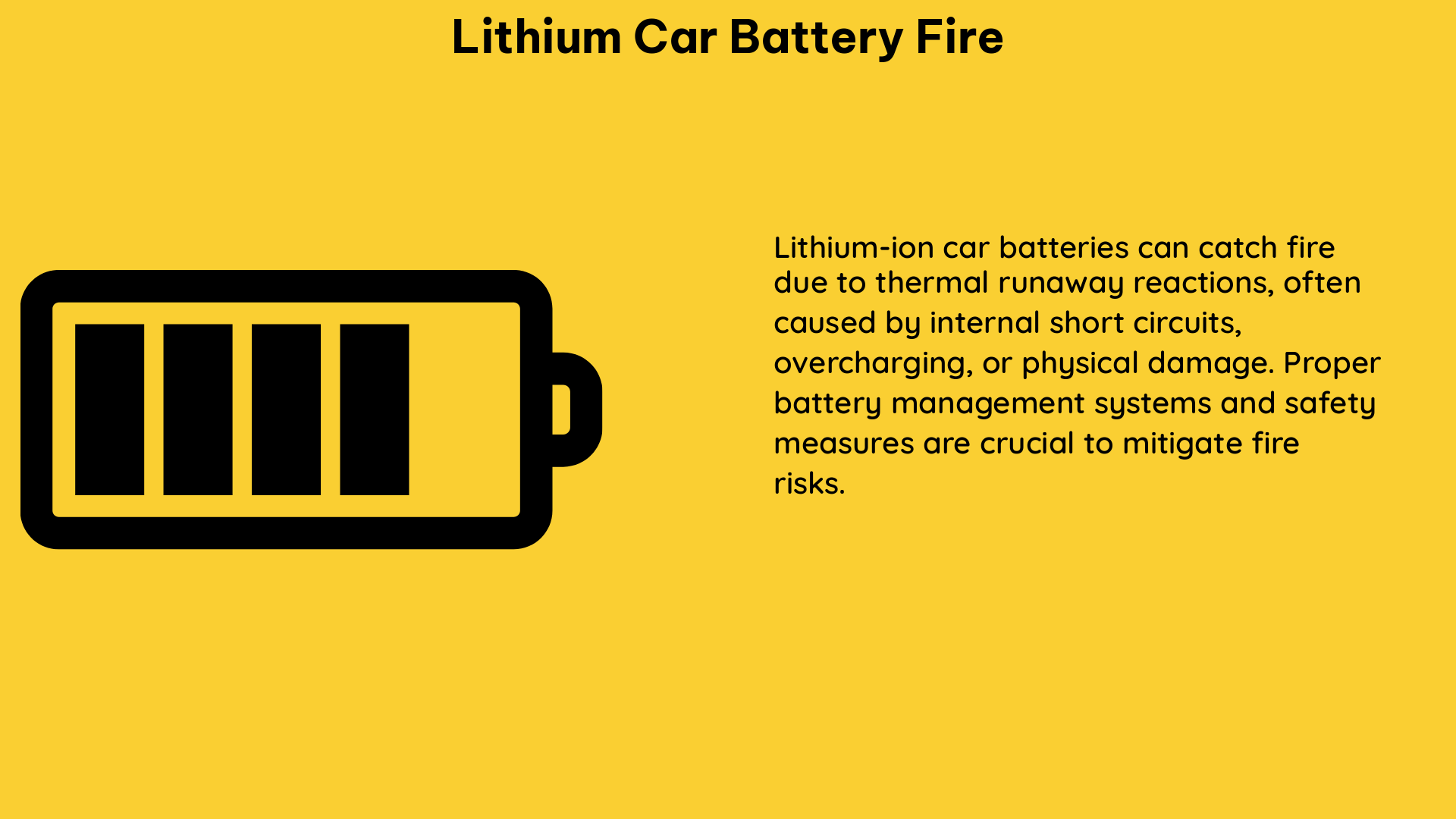Lithium car battery fires can release a significant amount of heat and toxic gases, posing a serious risk to both human safety and property. These fires can reach peak heat release rates (HRR) of approximately 1.1 megawatts (MW), which is about 7 times higher than a typical internal combustion engine fire, and can last for 1-2 minutes. The toxic gases released during a lithium-ion battery fire can include hydrogen fluoride (HF), carbon monoxide (CO), and other harmful substances.
Understanding Lithium-Ion Battery Specifications
Lithium-ion batteries used in electric vehicles typically have the following technical specifications:
- Voltage range: 200-400 volts
- Capacity: 20-100 kilowatt-hours (kWh)
- Battery cells: 18650-type cylindrical cells
- Cell voltage: 3.6-3.7 volts
- Cell capacity: 2-3 Ah
These batteries are made up of multiple cells connected in series and parallel to achieve the desired voltage and capacity. The specific chemistry used in the battery can also affect the heat release rate and emission of toxic substances during a fire.
Mechanisms of Thermal Runaway

Thermal runaway is the primary mechanism that can lead to a lithium car battery fire. This can be initiated by two main factors:
- External Overheating: Defects in cell or battery design can cause external heating of the battery cells, leading to thermal runaway.
- Overcharging: Overcharging the battery cells, either due to the use of the wrong charger or failure of battery pack safety features, can also trigger thermal runaway.
To prevent thermal runaway, it is crucial to use appropriate chargers and ensure that battery packs are not subjected to external heating or overcharging.
Firefighting Techniques
Traditional fire-fighting methods, such as water spray or foam, can be ineffective and may even exacerbate a lithium car battery fire. Instead, the following techniques have been found to be more effective:
- Water Mist: Water mist has been shown to be effective in suppressing lithium-ion battery fires. The water mist can cool the batteries and prevent the spread of the fire.
- Dry Powder Extinguishers: Dry powder extinguishers, such as those containing sodium bicarbonate or potassium chloride, can also be used to fight lithium car battery fires.
- Thermal Runaway Containment: Specialized containment systems can be used to isolate and contain a thermal runaway event, preventing the fire from spreading.
It is important to note that the effectiveness of these firefighting techniques may vary depending on the specific battery chemistry and design, as well as the size and location of the fire.
Toxic Gas Emissions
During a lithium car battery fire, the release of toxic gases can pose a significant threat to human health and the environment. The main toxic gases that can be emitted include:
- Hydrogen Fluoride (HF): HF is a highly corrosive and toxic gas that can cause severe respiratory and skin irritation.
- Carbon Monoxide (CO): CO is a colorless, odorless gas that can be fatal in high concentrations.
- Other Harmful Substances: Depending on the battery chemistry, other toxic substances such as phosphine (PH3), sulfur dioxide (SO2), and volatile organic compounds (VOCs) may also be released.
Proper ventilation, personal protective equipment, and decontamination procedures are crucial when responding to a lithium car battery fire to minimize the risk of exposure to these toxic gases.
Conclusion
Lithium car battery fires pose a significant risk due to their high heat release rates and the release of toxic gases. Understanding the technical specifications of these batteries, the mechanisms of thermal runaway, and the appropriate firefighting techniques is essential for ensuring the safety of both first responders and the general public. By staying informed and implementing the necessary precautions, we can mitigate the dangers associated with lithium car battery fires.
References:
– Sturm, P. F., Fößleitner, P., Fruhwirt, D., Galler, R., Wenighofer, R., Heindl, R., … & Krausbar, S. (2022). Fire tests with lithium-ion battery electric vehicles in road tunnels. Safety Science, 138, 105600.
– Experiments Completed for Intentional Thermal Runaway on Lithium-Ion Batteries (2022). Fire Safety Research Institute.
– Lithium-Ion Battery Fire Statistics: Market Report & Data (2022). Gitnux.
– Multi-Risk Assessment of Mine Lithium Battery Fire Based on Comprehensive Evaluation Index System (2022). National Center for Biotechnology Information.
– Toxic Fluoride Gas Emissions from Lithium-Ion Battery Fires (2017). National Center for Biotechnology Information.

The lambdageeks.com Core SME Team is a group of experienced subject matter experts from diverse scientific and technical fields including Physics, Chemistry, Technology,Electronics & Electrical Engineering, Automotive, Mechanical Engineering. Our team collaborates to create high-quality, well-researched articles on a wide range of science and technology topics for the lambdageeks.com website.
All Our Senior SME are having more than 7 Years of experience in the respective fields . They are either Working Industry Professionals or assocaited With different Universities. Refer Our Authors Page to get to know About our Core SMEs.